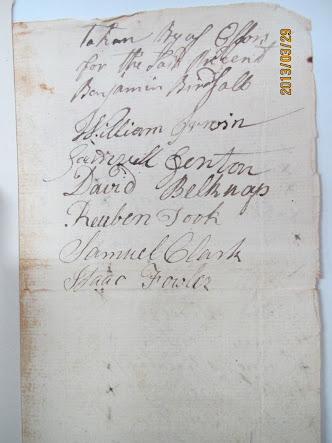On April 23, 1779, Captain Jacob Conklin published "A Exempt List" for his company. It contained 28 names including Joel Campbell. This could have referred to the father who was 44 years old or his son, also Joel, who was about 24.

Photo of the original document by the author. I believe the document resides at The George Washington Headquarters Museum in Newburgh.
There was a companion document at the GWHQ Museum that I believe is related to this one. One side contains Captain Conklin's name and the amount of £104, the exact same total as on the List of Exempts. On the reverse is a title transcribed as "Taken by of Cl[a?]ssors? for the Said Precenct", followed by seven names of prominent citizens, presumed to have collected the Exempt Fee from those on the Exempt List (see below).
The New York Militia Throughout the entire Revolutionary War, all men between the
ages of sixteen and fifty were subject to compulsory militia service. Militia service usually was for short periods of time within the locality of the militiaman whereas "continental" service (George Washington's army) was generally for a longer period and could be anywhere in the colonies. Both Joel and his son, Joel, were subject to militia service.
"Classes" in the Militia When it became necessary to engage the militia for periods of longer than a week at locations farther from their home, it became the practice to only require one third of each company to march. The remaining two thirds stayed behind to protect the community and run the farms and businesses that in many cases were feeding, clothing, or arming the continental forces. To facilitate this, "classes" of three persons were often formed, with one of the three marching and the other two remaining. The person in the class who marched was normally compensated by the other two. It appears that officers also formed classes, resulting in expedition companies that were a mixture of militiamen from several different home companies. The second document indicates the payments made by the Exempts were connected with "Classes." Joel may have been part of a class where the payment was not to the serving soldier, but to the Precinct officials?
Exemption from Militia Service Several militia laws were passed by New York during the Revolution. All of them fine-tuned the qualifications for "exemption." By the end of the War, the exemption qualification became so general that it included all those "engaged or employed in any Manufacture or Business, so that it would be for the Good of the Public..." and subject to approval of the Commander in Chief of the New York Militia (the Governor). Explicitly exempt (often with stipulations) were Quakers (religious), "Lieutenant Governor, the members of the State Senate and Assembly, their several clerks, the Secretary of State, the Attorney General, the Auditor General, the State Treasurer, judicial officers and their clerks as well as sheriffs and county clerks," sheriff's deputies, gaolers(jailers), coroners, ministers, doctors, ferrymen, millers, schoolmasters, essential war workers (makers of arms, powder, clothing ... including "Wood Cutters, Blacksmiths, Coopers, Colliers & Carpenters.") [see Alexander, Arthur J. “EXEMPTION FROM MILITIA SERVICE IN NEW YORK STATE DURING THE REVOLUTIONARY WAR.” New York History, vol. 27, no. 2, 1946, pp. 204–12.] Exempted individuals were assessed a fee in lieu of service. For Quakers the fee was £10 in 1777. The list of exempted occupations would suggest Joel had a trade, but the 1793 deed describes him as a yeoman.
Summary Included in the List of Exempts is Captain Conklin and all of his commissioned officers. This seems a bit odd to me unless the exemption is due to service in a recent expedition and not to some civic responsibility at home. If the latter were the case, why were they ever selected as officers? If the former is the case, could that also be the reason for exemption of others on the list, including Joel? No service records for Joel or Conklin's company in the winter of 1778-79 have been found.
Residence in 1779 The members of Conklin's company were generally from western Newburgh. Twelve of the 28 exempts were signers of the Newburgh Pledge of 1775. [See Ruttenber's HISTORY OF NEWBURGH]. One was a signer of the New Marlborough Pledge. [See Bond's HISTORY OF MARLBOROUGH]. Joel was living further east than his residence in the 1790 census of Montgomery.
Net Worth in 1779 Of the 28 Exempts, Joel and 4 others were assessed the lowest amount of £1 4. If the fee was assessed in proportion to net worth, then Joel was on the low end. The highest assessed person was Henry W. Kipp at £20.


No comments:
Post a Comment